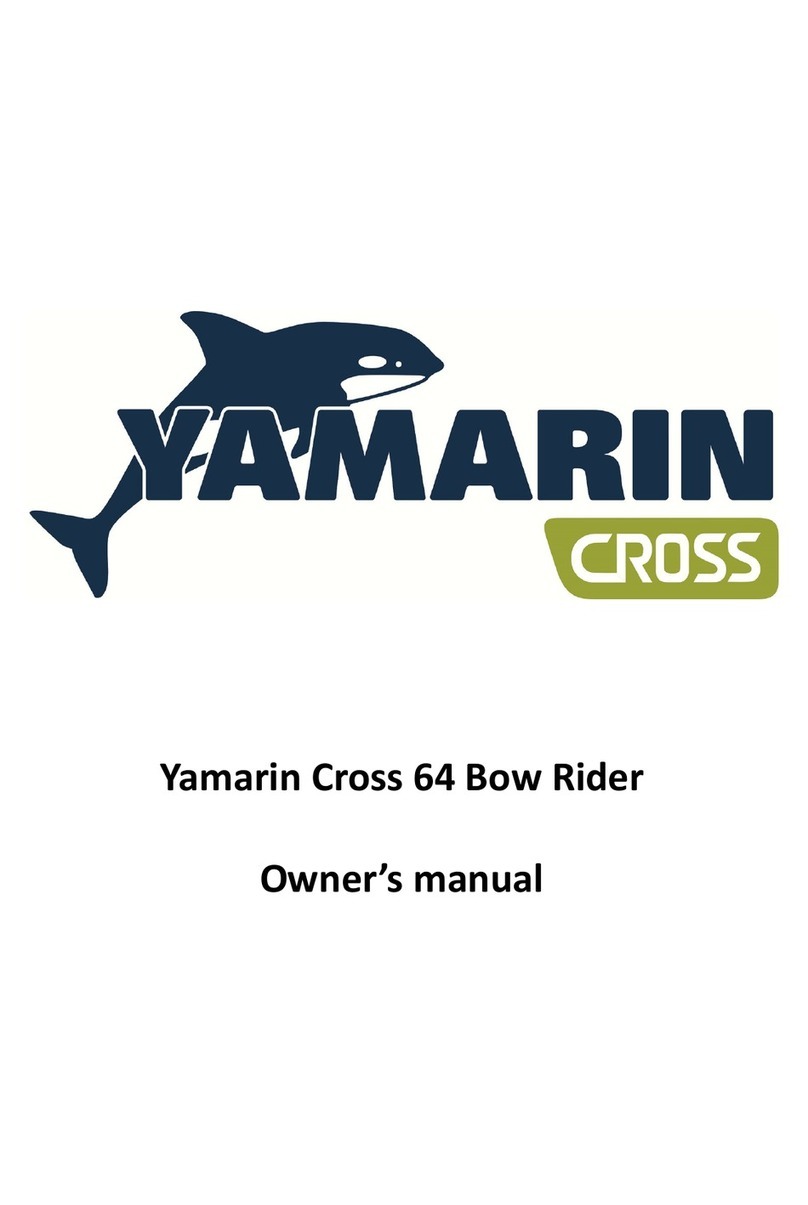
7
2/2
3Such as non-harmonised standards, rules, regulations, guidelines, etc.
4Standards published in EU Official Journal
5See Declaration of Conformity of engine manufacturer
6Only to be completed for boats with inboard engines or sterndrive engines without integral exhaust
Essential requirements
(reference to relevant articles in
Annex IA & IC of the Directive)
Harmonised standards
Full Application
Harmonised standards
Partial application, see tech. file
Other reference documents
3
Full Application
Other reference documents
Partial Application , see tech. file
Other proof of conformity
See technical. file
Specify the harmonised 4standards
or other reference documents used
(with year of publication like “EN ISO 8666:2002”)
Tick only one box per line All lines right of ticked boxes must be filled in
General requirements (2)
Principal data – main dimensions
Watercraft Identification Number – WIN (2.1)
Watercraft Builder’s Plate (2.2)
Protection from falling overboard and means of reboarding (2.3)
Visibility from the main steering position (2.4)
Owner’s manual (2.5)
Integrity and structural requirements (3)
Structure (3.1)
Stability and freeboard (3.2)
Buoyancy and flotation (3.3)
Openings in hull, deck and superstructure (3.4)
Flooding (3.5)
Manufacturer’s maximum recommended load (3.6)
Liferaft stowage (3.7)
Escape (3.8)
Anchoring, mooring and towing (3.9)
Handling characteristics (4)
Engines and engine spaces (5.1)
Inboard engine (5.1.1)
Ventilation (5.1.2)
Exposed parts (5.1.3)
Outboard engine starting (5.1.4)
Fuel system (5.2)
General – fuel system (5.2.1)
Fuel tanks (5.2.2)
Electrical systems (5.3)
Steering systems (5.4)
General – steering system (5.4.1)
Emergency arrangements (5.4.2)
Gas systems (5.5)
Fire protection (5.6)
General – fire protection (5.6.1)
Fire-fighting equipment (5.6.2)
Navigation lights, shapes and sound signals (5.7)
Discharge prevention (5.8)
Annex I.B – Exhaust Emissions 5
Annex I.C – Noise Emissions 6
Noise emissions level (I.C.1)
Owner’s manual (I.C.2)
The empty template was compiled and made available by the International Marine Certification Institute at www.imci.org. This document is under the sole responsibility of the manufacturer.
EN
8666:2002
ISO 10087:2006
ISO 14945:2004/AC:2005
ISO 15085:2003/A1:2009
ISO 11591:2011
ISO 10240:2004
ISO 12215-3:2002, EN ISO 12215-4:2002, EN ISO
12215-5:2008/A1:2014, EN ISO 12215-6:2008
ISO 12217-3:2015
ISO 12217-3:2015
ISO 9093-1:1997, EN ISO 9093-2:2002, EN ISO 12216:2002
ISO 11812:2001, EN ISO 15083:2003
ISO 14946:2001/AC:2005
Annex I 3.7
ISO 15084:2003
ISO 11592:2001
ISO 8469:2013, EN ISO 10088:2013, EN ISO 21487:2012/A1:2014
ISO 21487:2012+A2:2015
ISO 8849:2003, EN ISO 10133:2012
ISO 8847:2017, EN ISO 10592:2017, EN ISO 25197:2012+A1:2014,
ISO 9094-1:2003
ISO 9094-1:2003
ISO 16180:2013, 1972 COLREG






























